Money Multiplier and Keynesian vs Classical Views
VerifiedAdded on 2019/09/20
|6
|1446
|207
Essay
AI Summary
This essay delves into the concept of the money multiplier, explaining its theoretical calculation and real-world limitations, such as taxes and import spending. It also contrasts Keynesian and classical economic views on unemployment, highlighting the role of wage rigidity and price flexibility. Furthermore, the essay analyzes the determination of interest rates in the money market and its impact on investment expenditure. Finally, it discusses how the economy adjusts to changes in aggregate demand according to classical economists, emphasizing the self-correcting mechanism through price and wage flexibility.
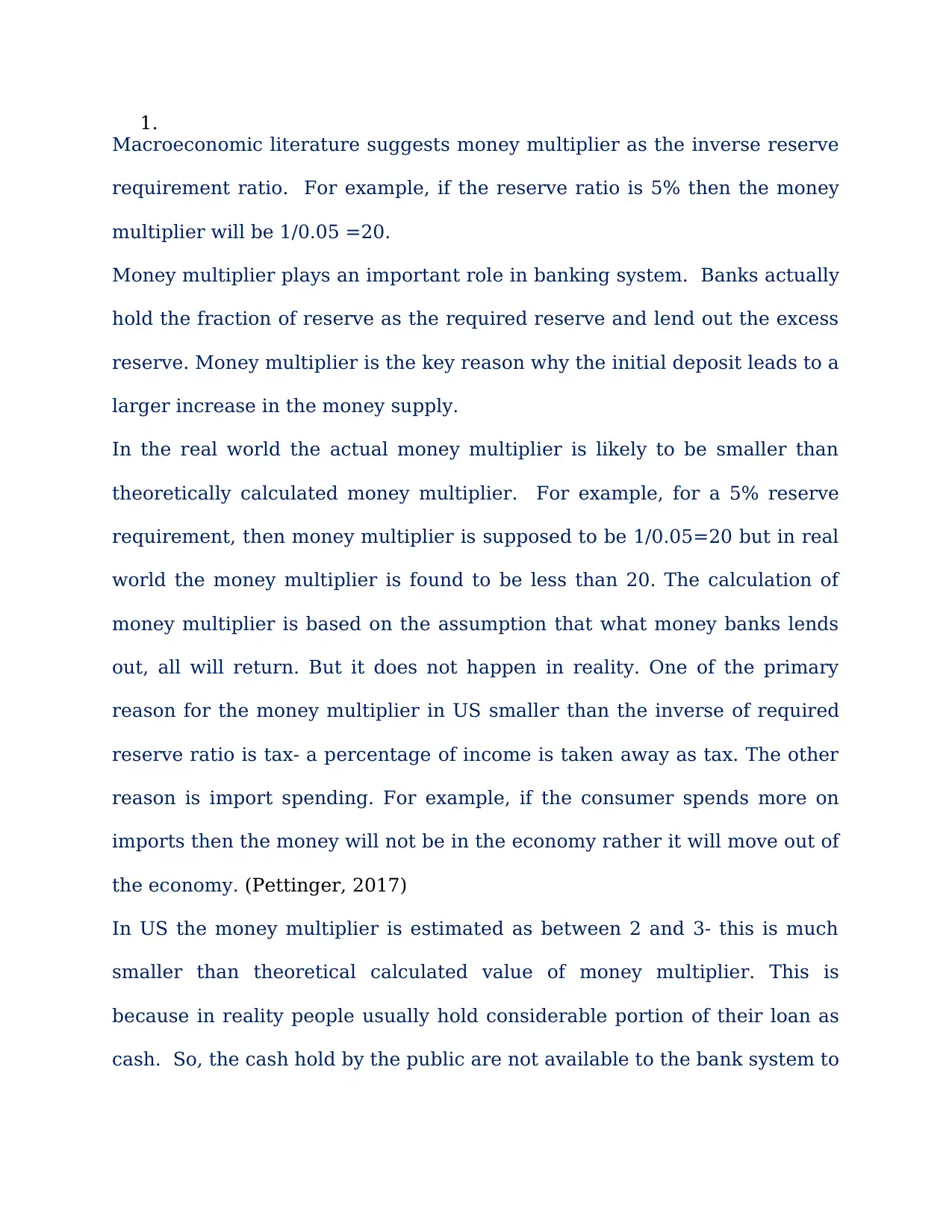
1.
Macroeconomic literature suggests money multiplier as the inverse reserve
requirement ratio. For example, if the reserve ratio is 5% then the money
multiplier will be 1/0.05 =20.
Money multiplier plays an important role in banking system. Banks actually
hold the fraction of reserve as the required reserve and lend out the excess
reserve. Money multiplier is the key reason why the initial deposit leads to a
larger increase in the money supply.
In the real world the actual money multiplier is likely to be smaller than
theoretically calculated money multiplier. For example, for a 5% reserve
requirement, then money multiplier is supposed to be 1/0.05=20 but in real
world the money multiplier is found to be less than 20. The calculation of
money multiplier is based on the assumption that what money banks lends
out, all will return. But it does not happen in reality. One of the primary
reason for the money multiplier in US smaller than the inverse of required
reserve ratio is tax- a percentage of income is taken away as tax. The other
reason is import spending. For example, if the consumer spends more on
imports then the money will not be in the economy rather it will move out of
the economy. (Pettinger, 2017)
In US the money multiplier is estimated as between 2 and 3- this is much
smaller than theoretical calculated value of money multiplier. This is
because in reality people usually hold considerable portion of their loan as
cash. So, the cash hold by the public are not available to the bank system to
Macroeconomic literature suggests money multiplier as the inverse reserve
requirement ratio. For example, if the reserve ratio is 5% then the money
multiplier will be 1/0.05 =20.
Money multiplier plays an important role in banking system. Banks actually
hold the fraction of reserve as the required reserve and lend out the excess
reserve. Money multiplier is the key reason why the initial deposit leads to a
larger increase in the money supply.
In the real world the actual money multiplier is likely to be smaller than
theoretically calculated money multiplier. For example, for a 5% reserve
requirement, then money multiplier is supposed to be 1/0.05=20 but in real
world the money multiplier is found to be less than 20. The calculation of
money multiplier is based on the assumption that what money banks lends
out, all will return. But it does not happen in reality. One of the primary
reason for the money multiplier in US smaller than the inverse of required
reserve ratio is tax- a percentage of income is taken away as tax. The other
reason is import spending. For example, if the consumer spends more on
imports then the money will not be in the economy rather it will move out of
the economy. (Pettinger, 2017)
In US the money multiplier is estimated as between 2 and 3- this is much
smaller than theoretical calculated value of money multiplier. This is
because in reality people usually hold considerable portion of their loan as
cash. So, the cash hold by the public are not available to the bank system to
Paraphrase This Document
Need a fresh take? Get an instant paraphrase of this document with our AI Paraphraser
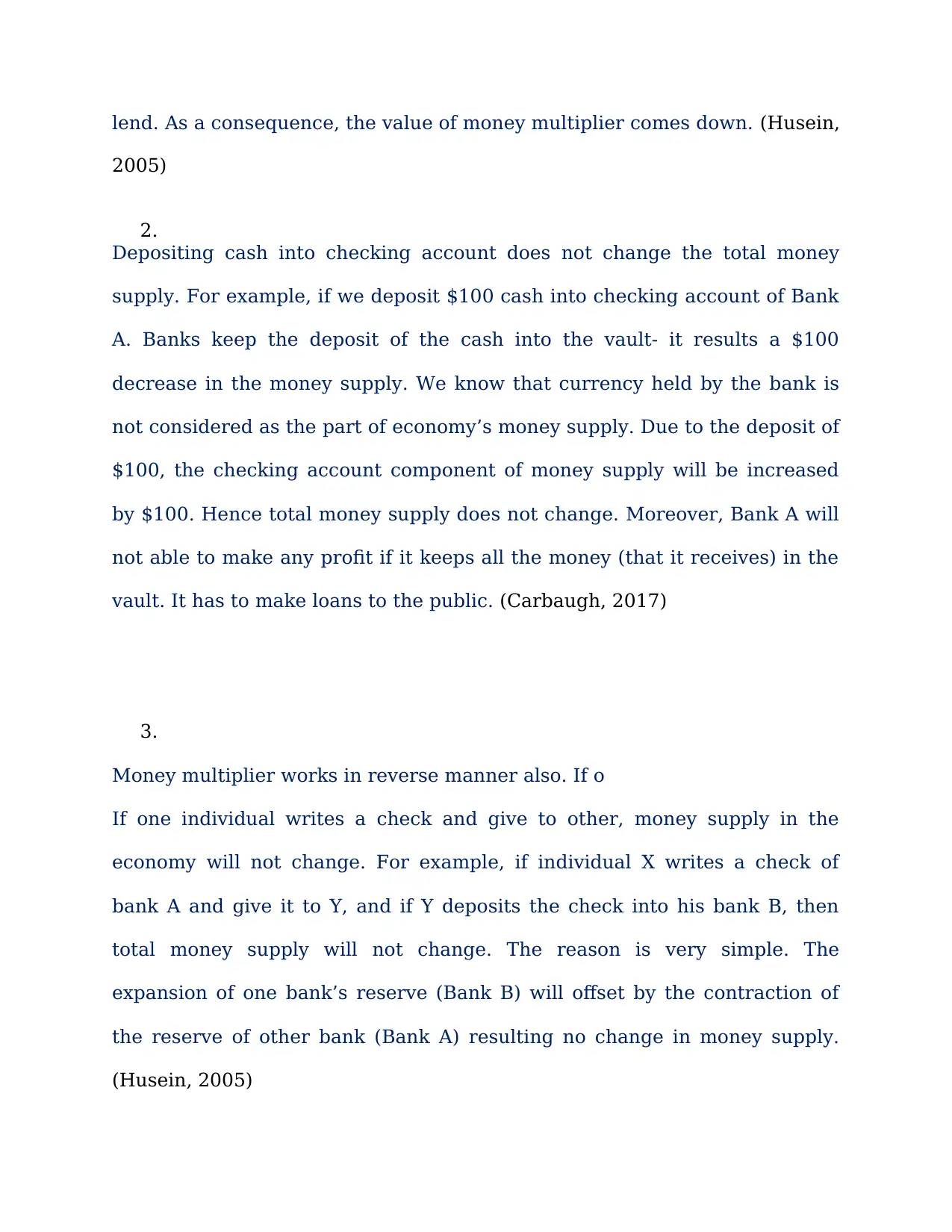
lend. As a consequence, the value of money multiplier comes down. (Husein,
2005)
2.
Depositing cash into checking account does not change the total money
supply. For example, if we deposit $100 cash into checking account of Bank
A. Banks keep the deposit of the cash into the vault- it results a $100
decrease in the money supply. We know that currency held by the bank is
not considered as the part of economy’s money supply. Due to the deposit of
$100, the checking account component of money supply will be increased
by $100. Hence total money supply does not change. Moreover, Bank A will
not able to make any profit if it keeps all the money (that it receives) in the
vault. It has to make loans to the public. (Carbaugh, 2017)
3.
Money multiplier works in reverse manner also. If o
If one individual writes a check and give to other, money supply in the
economy will not change. For example, if individual X writes a check of
bank A and give it to Y, and if Y deposits the check into his bank B, then
total money supply will not change. The reason is very simple. The
expansion of one bank’s reserve (Bank B) will offset by the contraction of
the reserve of other bank (Bank A) resulting no change in money supply.
(Husein, 2005)
2005)
2.
Depositing cash into checking account does not change the total money
supply. For example, if we deposit $100 cash into checking account of Bank
A. Banks keep the deposit of the cash into the vault- it results a $100
decrease in the money supply. We know that currency held by the bank is
not considered as the part of economy’s money supply. Due to the deposit of
$100, the checking account component of money supply will be increased
by $100. Hence total money supply does not change. Moreover, Bank A will
not able to make any profit if it keeps all the money (that it receives) in the
vault. It has to make loans to the public. (Carbaugh, 2017)
3.
Money multiplier works in reverse manner also. If o
If one individual writes a check and give to other, money supply in the
economy will not change. For example, if individual X writes a check of
bank A and give it to Y, and if Y deposits the check into his bank B, then
total money supply will not change. The reason is very simple. The
expansion of one bank’s reserve (Bank B) will offset by the contraction of
the reserve of other bank (Bank A) resulting no change in money supply.
(Husein, 2005)
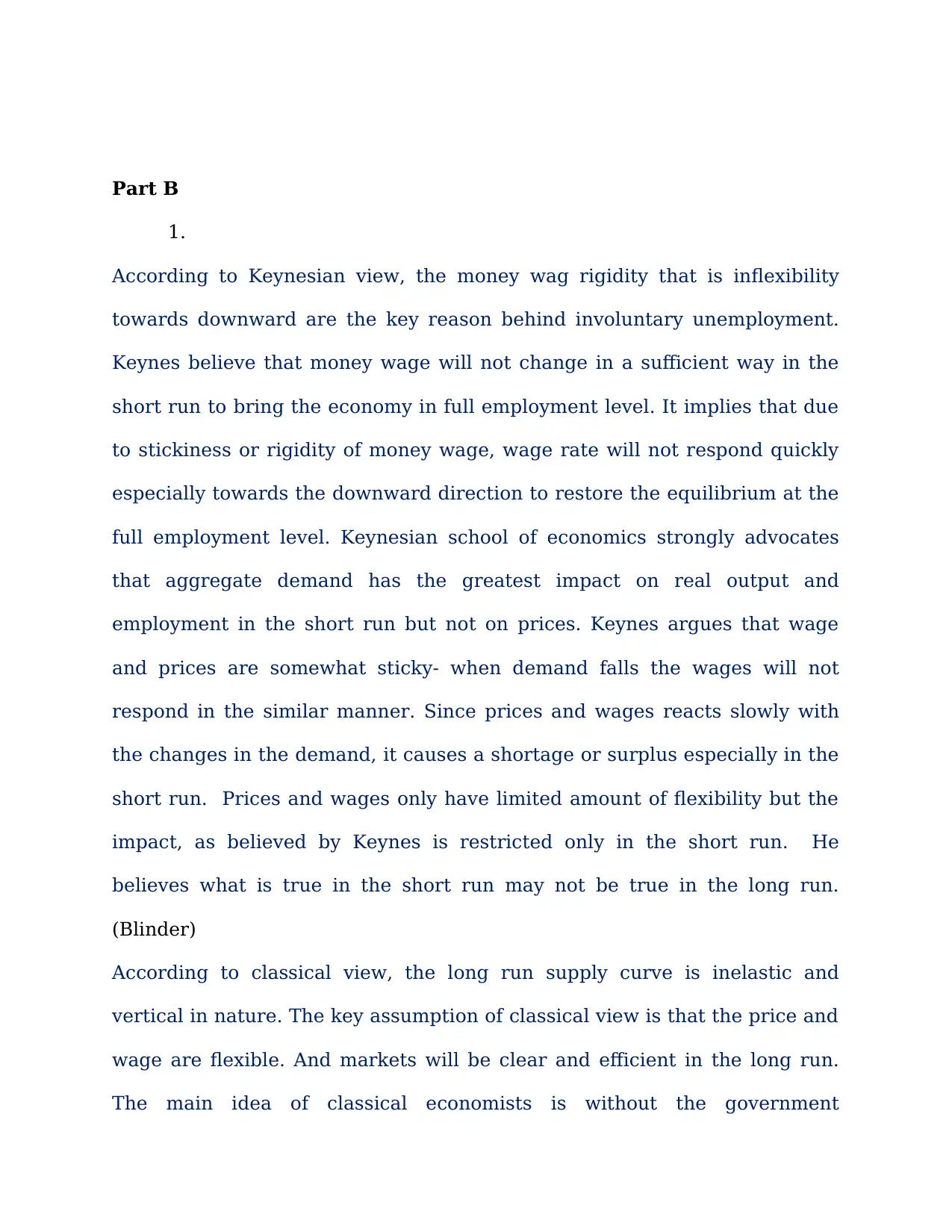
Part B
1.
According to Keynesian view, the money wag rigidity that is inflexibility
towards downward are the key reason behind involuntary unemployment.
Keynes believe that money wage will not change in a sufficient way in the
short run to bring the economy in full employment level. It implies that due
to stickiness or rigidity of money wage, wage rate will not respond quickly
especially towards the downward direction to restore the equilibrium at the
full employment level. Keynesian school of economics strongly advocates
that aggregate demand has the greatest impact on real output and
employment in the short run but not on prices. Keynes argues that wage
and prices are somewhat sticky- when demand falls the wages will not
respond in the similar manner. Since prices and wages reacts slowly with
the changes in the demand, it causes a shortage or surplus especially in the
short run. Prices and wages only have limited amount of flexibility but the
impact, as believed by Keynes is restricted only in the short run. He
believes what is true in the short run may not be true in the long run.
(Blinder)
According to classical view, the long run supply curve is inelastic and
vertical in nature. The key assumption of classical view is that the price and
wage are flexible. And markets will be clear and efficient in the long run.
The main idea of classical economists is without the government
1.
According to Keynesian view, the money wag rigidity that is inflexibility
towards downward are the key reason behind involuntary unemployment.
Keynes believe that money wage will not change in a sufficient way in the
short run to bring the economy in full employment level. It implies that due
to stickiness or rigidity of money wage, wage rate will not respond quickly
especially towards the downward direction to restore the equilibrium at the
full employment level. Keynesian school of economics strongly advocates
that aggregate demand has the greatest impact on real output and
employment in the short run but not on prices. Keynes argues that wage
and prices are somewhat sticky- when demand falls the wages will not
respond in the similar manner. Since prices and wages reacts slowly with
the changes in the demand, it causes a shortage or surplus especially in the
short run. Prices and wages only have limited amount of flexibility but the
impact, as believed by Keynes is restricted only in the short run. He
believes what is true in the short run may not be true in the long run.
(Blinder)
According to classical view, the long run supply curve is inelastic and
vertical in nature. The key assumption of classical view is that the price and
wage are flexible. And markets will be clear and efficient in the long run.
The main idea of classical economists is without the government
⊘ This is a preview!⊘
Do you want full access?
Subscribe today to unlock all pages.

Trusted by 1+ million students worldwide

intervention, the market will be clear and full employment will be restored
due to flexibility of price and wage. With the flexibility of prices, full
employment can be attained without the intervention of government
policies. Whenever there is any surplus or shortage exists , flexibility of
price help to quickly eliminate the gap and maintain the full employment in
the long run, as viewed by Classical economists. (Kathryn Dominguez,
Winter 2010 )
2.
Let us start with the graph (B). How the interest rate is determined that
can be explained through the money market as illustrated in Figure (B). In
the money market, money supply is fixed as shown in the vertical curve M.
Money demand function is downward sloping. Interest rate (r1) in the
economy is determined where Money demand function Md and the money
supply function M intersects to each other at point d. As the money demand
increases from Mod to M1d , there will be a surge in the interest rate. The
rate of interest will increase from r0 to r1.
due to flexibility of price and wage. With the flexibility of prices, full
employment can be attained without the intervention of government
policies. Whenever there is any surplus or shortage exists , flexibility of
price help to quickly eliminate the gap and maintain the full employment in
the long run, as viewed by Classical economists. (Kathryn Dominguez,
Winter 2010 )
2.
Let us start with the graph (B). How the interest rate is determined that
can be explained through the money market as illustrated in Figure (B). In
the money market, money supply is fixed as shown in the vertical curve M.
Money demand function is downward sloping. Interest rate (r1) in the
economy is determined where Money demand function Md and the money
supply function M intersects to each other at point d. As the money demand
increases from Mod to M1d , there will be a surge in the interest rate. The
rate of interest will increase from r0 to r1.
Paraphrase This Document
Need a fresh take? Get an instant paraphrase of this document with our AI Paraphraser
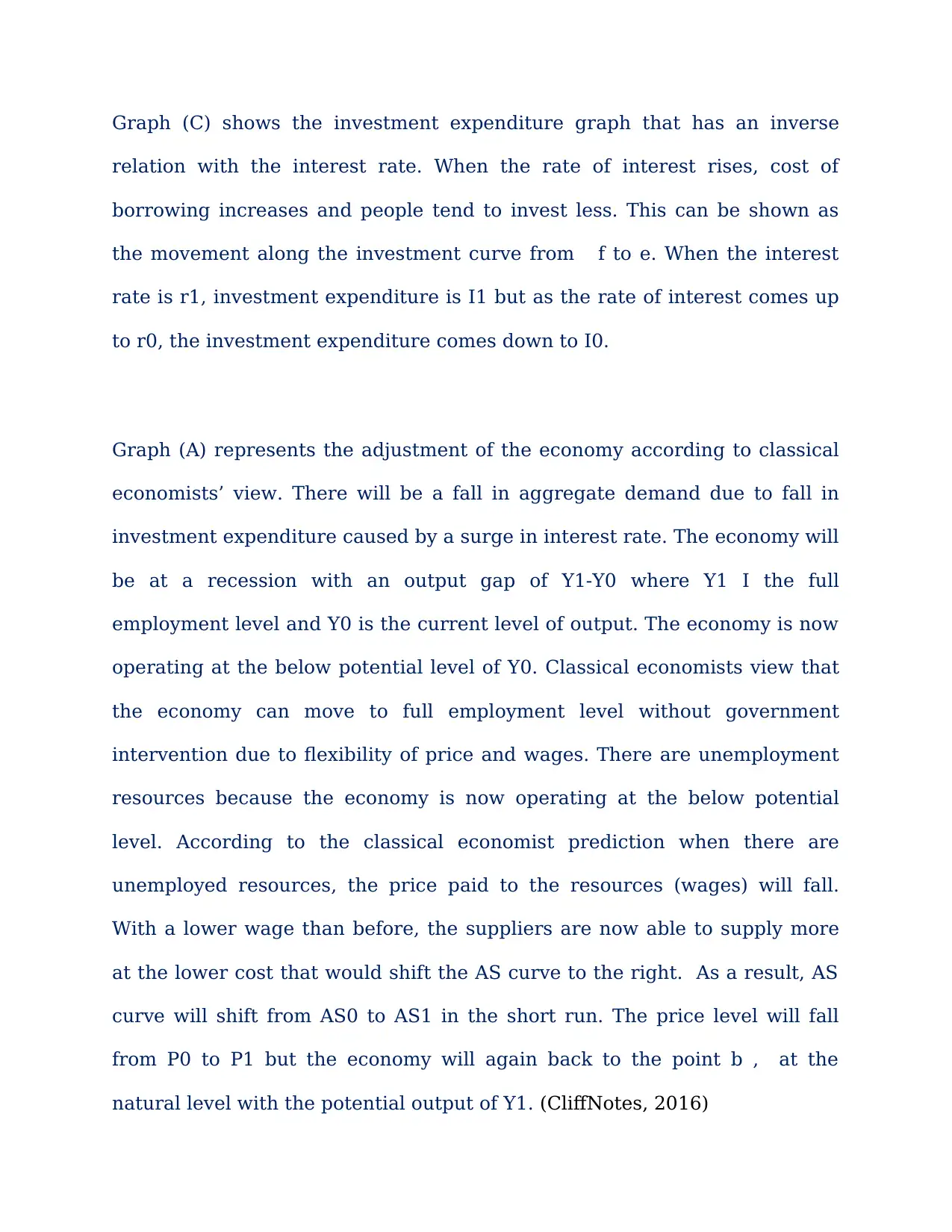
Graph (C) shows the investment expenditure graph that has an inverse
relation with the interest rate. When the rate of interest rises, cost of
borrowing increases and people tend to invest less. This can be shown as
the movement along the investment curve from f to e. When the interest
rate is r1, investment expenditure is I1 but as the rate of interest comes up
to r0, the investment expenditure comes down to I0.
Graph (A) represents the adjustment of the economy according to classical
economists’ view. There will be a fall in aggregate demand due to fall in
investment expenditure caused by a surge in interest rate. The economy will
be at a recession with an output gap of Y1-Y0 where Y1 I the full
employment level and Y0 is the current level of output. The economy is now
operating at the below potential level of Y0. Classical economists view that
the economy can move to full employment level without government
intervention due to flexibility of price and wages. There are unemployment
resources because the economy is now operating at the below potential
level. According to the classical economist prediction when there are
unemployed resources, the price paid to the resources (wages) will fall.
With a lower wage than before, the suppliers are now able to supply more
at the lower cost that would shift the AS curve to the right. As a result, AS
curve will shift from AS0 to AS1 in the short run. The price level will fall
from P0 to P1 but the economy will again back to the point b , at the
natural level with the potential output of Y1. (CliffNotes, 2016)
relation with the interest rate. When the rate of interest rises, cost of
borrowing increases and people tend to invest less. This can be shown as
the movement along the investment curve from f to e. When the interest
rate is r1, investment expenditure is I1 but as the rate of interest comes up
to r0, the investment expenditure comes down to I0.
Graph (A) represents the adjustment of the economy according to classical
economists’ view. There will be a fall in aggregate demand due to fall in
investment expenditure caused by a surge in interest rate. The economy will
be at a recession with an output gap of Y1-Y0 where Y1 I the full
employment level and Y0 is the current level of output. The economy is now
operating at the below potential level of Y0. Classical economists view that
the economy can move to full employment level without government
intervention due to flexibility of price and wages. There are unemployment
resources because the economy is now operating at the below potential
level. According to the classical economist prediction when there are
unemployed resources, the price paid to the resources (wages) will fall.
With a lower wage than before, the suppliers are now able to supply more
at the lower cost that would shift the AS curve to the right. As a result, AS
curve will shift from AS0 to AS1 in the short run. The price level will fall
from P0 to P1 but the economy will again back to the point b , at the
natural level with the potential output of Y1. (CliffNotes, 2016)
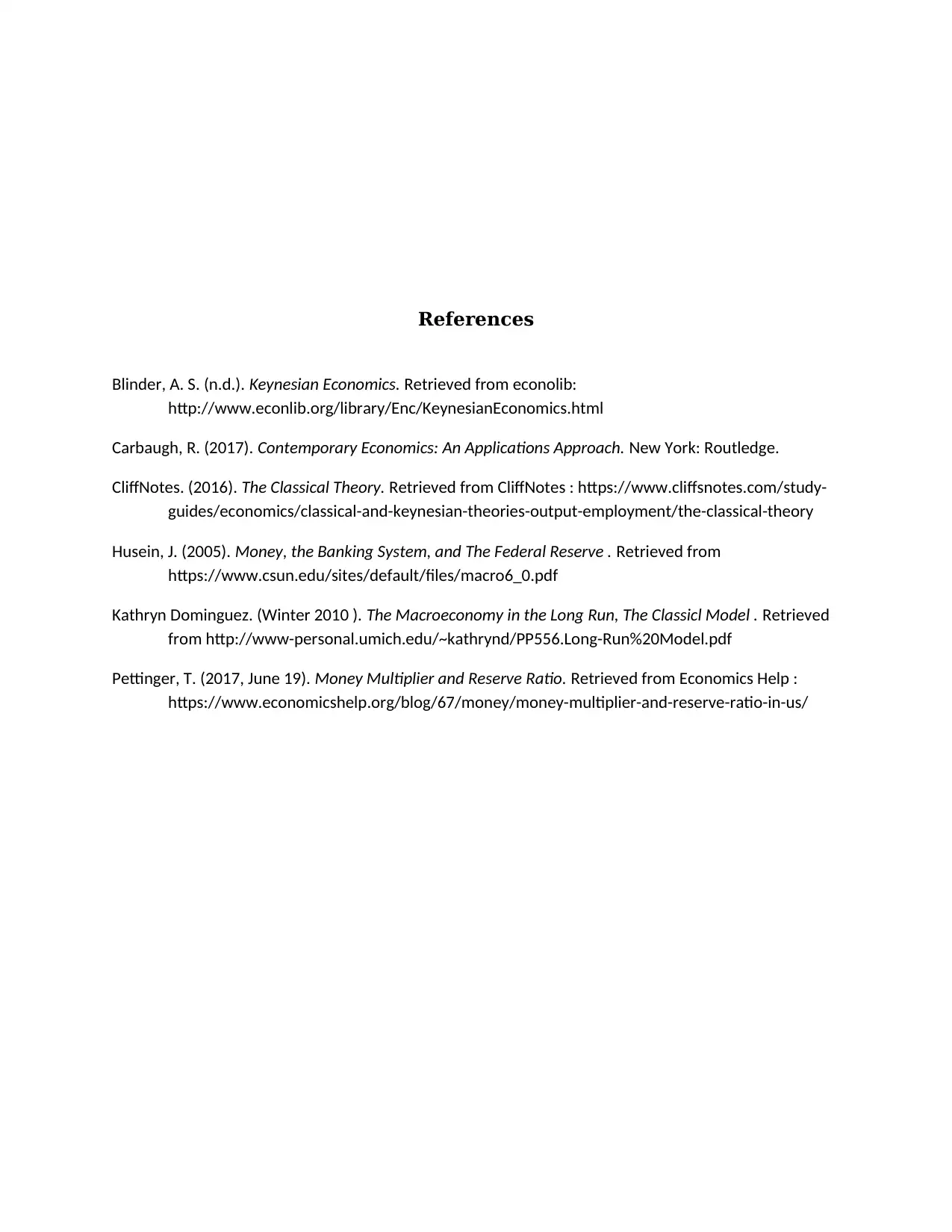
References
Blinder, A. S. (n.d.). Keynesian Economics. Retrieved from econolib:
http://www.econlib.org/library/Enc/KeynesianEconomics.html
Carbaugh, R. (2017). Contemporary Economics: An Applications Approach. New York: Routledge.
CliffNotes. (2016). The Classical Theory. Retrieved from CliffNotes : https://www.cliffsnotes.com/study-
guides/economics/classical-and-keynesian-theories-output-employment/the-classical-theory
Husein, J. (2005). Money, the Banking System, and The Federal Reserve . Retrieved from
https://www.csun.edu/sites/default/files/macro6_0.pdf
Kathryn Dominguez. (Winter 2010 ). The Macroeconomy in the Long Run, The Classicl Model . Retrieved
from http://www-personal.umich.edu/~kathrynd/PP556.Long-Run%20Model.pdf
Pettinger, T. (2017, June 19). Money Multiplier and Reserve Ratio. Retrieved from Economics Help :
https://www.economicshelp.org/blog/67/money/money-multiplier-and-reserve-ratio-in-us/
Blinder, A. S. (n.d.). Keynesian Economics. Retrieved from econolib:
http://www.econlib.org/library/Enc/KeynesianEconomics.html
Carbaugh, R. (2017). Contemporary Economics: An Applications Approach. New York: Routledge.
CliffNotes. (2016). The Classical Theory. Retrieved from CliffNotes : https://www.cliffsnotes.com/study-
guides/economics/classical-and-keynesian-theories-output-employment/the-classical-theory
Husein, J. (2005). Money, the Banking System, and The Federal Reserve . Retrieved from
https://www.csun.edu/sites/default/files/macro6_0.pdf
Kathryn Dominguez. (Winter 2010 ). The Macroeconomy in the Long Run, The Classicl Model . Retrieved
from http://www-personal.umich.edu/~kathrynd/PP556.Long-Run%20Model.pdf
Pettinger, T. (2017, June 19). Money Multiplier and Reserve Ratio. Retrieved from Economics Help :
https://www.economicshelp.org/blog/67/money/money-multiplier-and-reserve-ratio-in-us/
⊘ This is a preview!⊘
Do you want full access?
Subscribe today to unlock all pages.

Trusted by 1+ million students worldwide
1 out of 6
Related Documents
Your All-in-One AI-Powered Toolkit for Academic Success.
+13062052269
info@desklib.com
Available 24*7 on WhatsApp / Email
![[object Object]](/_next/static/media/star-bottom.7253800d.svg)
Unlock your academic potential
Copyright © 2020–2025 A2Z Services. All Rights Reserved. Developed and managed by ZUCOL.





